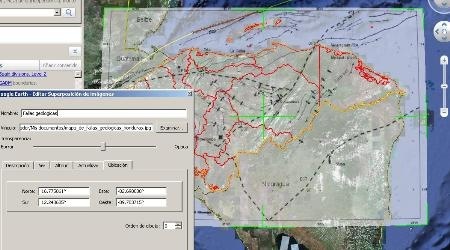TRANSLATION NOTES: Please read some comments at the end of this post.
Let’s suppose I want to show in a georeferenced way an image available on a website.
I had already spoken of this before, but in this case I would like to project a map that is not on my hard drive but online. This is the case of Honduras geological faults map that is available on Dr. Robert S. Rogers website.

1. Georeference it
First, we downloaded and located it on the hard disk.

For this purpose, and as it is a sheet with a scale greater than 1 in 1 million, georeference it in a quick way (**) is enough. This is done importing it as overlapping image and then stretching until limits coincide; in case of having the extremes coordinates, it would have been more accurate to insert them in lat/lon.
Besides, I have provided approximately 65% opacity.
Once this is done, save it as kml that only weighs 1 kb.
1. Modifying kml
First, let’s see that kml file doesn’t contains the image, but refers to a place where it is stored:
Fallas geologicas
91ffffff
http://geology.csustan.edu/rrogers/terranes.jpg 0.75
16.77506106182943
12.24368463513841
-82.69883751605062
-89.70371452334636
So to create kml files from other images, we only have to edit the file with notepad, changing the direction of the local disk with the image hosted on the web and its name. Note that, with notepad you can edit a kml file, not a kmz because it is a compressed file.
This can also be done from Google Earth, by modifying the layer properties. See that with just changing the url for any of the available maps on the web, I can make the deployment because they were exported in the same layout.

By the way, look now how it is shown the earthquakes’ epicenters since 1970.

Here you can see the kml of the example.
TRANSLATION NOTES:
(*) al chilazo: this expression is used when you are doing something in a quick way.
 Autocad Software, Bentley Microstation, Gis Google Earth, Gis System Geomate Provides Services For Complete Gis Software And Solutions, Autocad Software, Autocad Courses, Bentley Microstation, Microstation Software, Gis Google Earth, Open Source Gis And More.
Autocad Software, Bentley Microstation, Gis Google Earth, Gis System Geomate Provides Services For Complete Gis Software And Solutions, Autocad Software, Autocad Courses, Bentley Microstation, Microstation Software, Gis Google Earth, Open Source Gis And More.